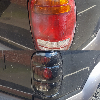Bwana Bob
Well-Known Member
- Joined
- February 2, 2002
- Messages
- 757
- Reaction score
- 8
- City, State
- Morris Plains, NJ
- Year, Model & Trim Level
- 92 XLT
I'm still having trouble with my '92 XLT. If I accelerate hard with the rpm's below 2000, it jerks and bucks until the rpm's get above 2000. I checked the plug wires, cleaned the MAF, replaced O2 sensor and fuel filter. Still no joy.
I suspect that the fuel pressure regulator (FPR) is not boosting the pressure when the vacuum drops under hard acceleration because the engine acts like its starved for fuel.
It idles fine and there is no CEL. I measured fuel pump current and its 3.2 amps. When I disconnect the FPR vacuum line the current increases to 3.6 amps. The FPR is not leaking fuel into the vacuum line, as some have reported. I would like to check the fuel pump relay for excessive voltage drop but I can't find it. I think its near the power distributio box, but I popped the box out and looked around and don't see the relay, unless its inside the plastic housing that is underneath the power distribution box. If so, it will be hard to get at.
I still suspect the FPR, but I don't have a fuel pressure gauge to check it. Both the FPR and fuel pump were replaced a few years ago.
Any help is appreciated. Thanks.
Bwana Bob
I suspect that the fuel pressure regulator (FPR) is not boosting the pressure when the vacuum drops under hard acceleration because the engine acts like its starved for fuel.
It idles fine and there is no CEL. I measured fuel pump current and its 3.2 amps. When I disconnect the FPR vacuum line the current increases to 3.6 amps. The FPR is not leaking fuel into the vacuum line, as some have reported. I would like to check the fuel pump relay for excessive voltage drop but I can't find it. I think its near the power distributio box, but I popped the box out and looked around and don't see the relay, unless its inside the plastic housing that is underneath the power distribution box. If so, it will be hard to get at.
I still suspect the FPR, but I don't have a fuel pressure gauge to check it. Both the FPR and fuel pump were replaced a few years ago.
Any help is appreciated. Thanks.
Bwana Bob










